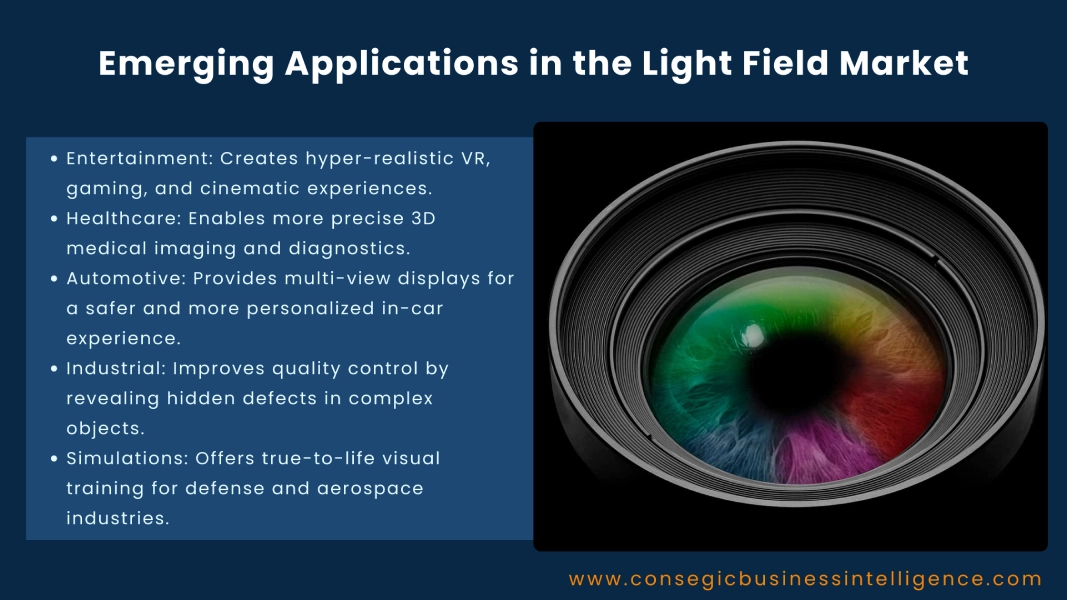Emerging Applications in the Light Field Market
Light field technology, which captures not only the intensity of light but also its direction, is transforming how digital content is created, viewed, and experienced. Unlike traditional imaging, light field systems can simulate natural depth, focus adjustments, and 3D visualization with stunning realism. This ability to replicate how humans perceive the real world is opening exciting opportunities across industries, from entertainment and healthcare to automotive and defense.

With rapid advances in sensors, displays, and computational imaging, the light field market is expanding into new applications that promise to change the way we interact with digital environments. Below are the most prominent emerging applications driving this dynamic industry forward.
- Immersive Entertainment and Media
One of the most visible applications of light field technology is in the entertainment industry. By creating highly realistic 3D imagery, light field systems are powering next-generation movies, virtual reality (VR), and augmented reality (AR) experiences. Viewers can enjoy lifelike visuals without the need for special glasses, while filmmakers gain more creative freedom in post-production with adjustable depth and focus. This is reshaping immersive media into a more natural and engaging experience.
- Virtual and Augmented Reality (VR/AR)
Light field displays are revolutionizing VR and AR by overcoming limitations such as eye strain and narrow fields of view. Unlike conventional stereoscopic systems, light field headsets provide true depth perception, making digital objects appear more natural and comfortable to the eyes. This is especially valuable in training simulations, gaming, and enterprise applications where prolonged usage is common. Companies developing AR smart glasses and VR platforms are increasingly integrating light field solutions to improve realism and usability.
- Medical Imaging and Healthcare
Healthcare is emerging as a major beneficiary of light field technology. In medical imaging, light field systems enable more accurate visualization of organs, tissues, and surgical sites in three dimensions. Surgeons can use these tools for preoperative planning or even live guidance during procedures. Light field microscopy is also advancing biomedical research, allowing scientists to capture cellular structures in greater detail. These innovations enhance precision, reduce risks, and improve patient outcomes.
- Automotive and Driver Assistance Systems
The automotive industry is exploring light field technology for both safety and user experience. Light field displays can provide drivers with 3D dashboards and navigation cues that reduce distraction and improve situational awareness. In autonomous vehicles, light field cameras are being tested for advanced perception systems that better recognize depth and objects in complex environments. This application combines safety innovation with immersive infotainment options for passengers.
- Holographic Communication
Light field technology is making futuristic holographic communication a reality. By reconstructing 3D images that can be viewed naturally from different angles, light field systems enable lifelike telepresence for remote meetings, education, and customer service. This is especially valuable in industries where physical presence enhances trust and interaction, such as healthcare consultations, collaborative design, and retail. As bandwidth and display technology improve, holographic communication is expected to become mainstream.
- Industrial Design and Engineering
In design and manufacturing, light field visualization is enabling engineers to interact with 3D prototypes in real time. Instead of relying solely on CAD models or 2D screens, designers can view and manipulate products as if they were physical objects. This accelerates prototyping, reduces errors, and improves collaboration between teams. Light field-based systems also allow stakeholders to review designs more intuitively, cutting costs in product development cycles.
- Education and Training
Education is being reshaped by immersive visualization technologies, and light field systems are at the forefront. From biology classrooms studying anatomical structures to vocational training programs simulating real-world scenarios, light field imaging enhances learning by making complex concepts easier to understand. In fields such as aviation, medicine, and defense, realistic simulations powered by light fields help trainees practice safely before entering high-stakes environments.
- Defense and Military Applications
Defense organizations are adopting light field technology for training, intelligence, and situational awareness. Light field visualization supports advanced flight simulators, battlefield simulations, and mission planning tools that improve preparedness. Additionally, light field cameras can provide enhanced depth perception in surveillance and reconnaissance, offering critical advantages in complex environments. These applications strengthen both training effectiveness and operational decision-making.
- E-commerce and Retail Visualization
Another emerging application is in online retail, where light field imaging helps customers interact with products in a more realistic way. Shoppers can view items from multiple angles and see true-to-life textures and details, reducing uncertainty in online purchases. Retailers are beginning to adopt light field-enabled product visualization to improve customer engagement and boost sales conversion rates.
Conclusion
The light field market is entering a transformative phase, with applications spreading across entertainment, healthcare, automotive, defense, education, and beyond. By replicating natural human vision, light field technology overcomes the limitations of traditional imaging and opens doors to entirely new experiences and capabilities.
As research progresses and hardware becomes more accessible, the applications of light field imaging and displays will expand further, shaping industries and creating new markets. From immersive movies to life-saving surgeries and safer driving experiences, light field technology is proving to be a cornerstone of the digital future.
